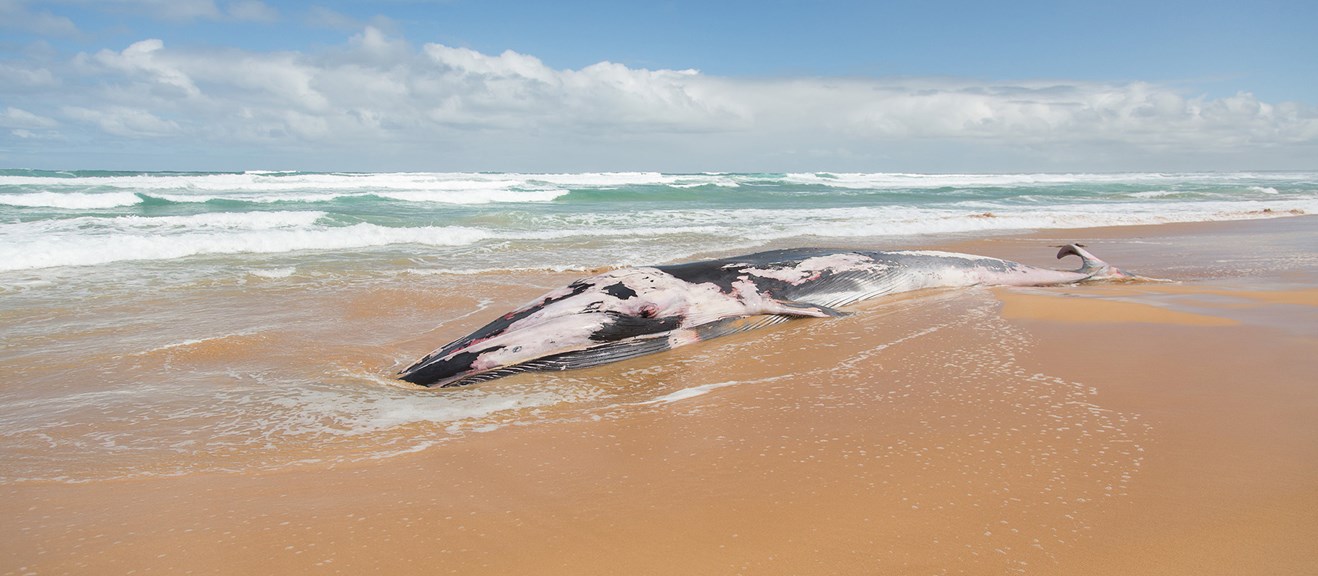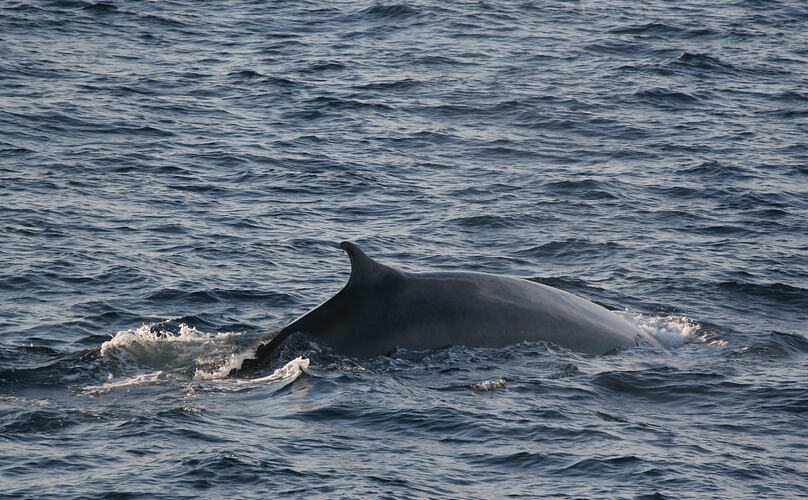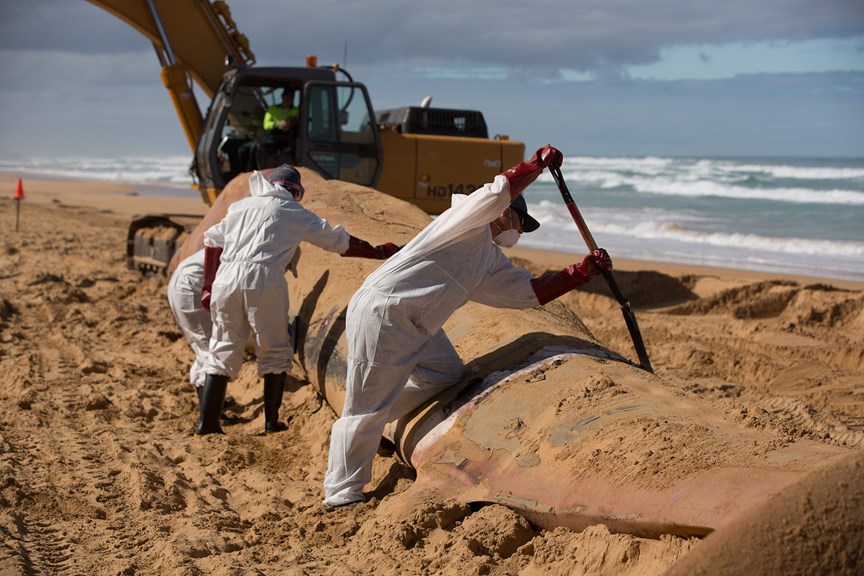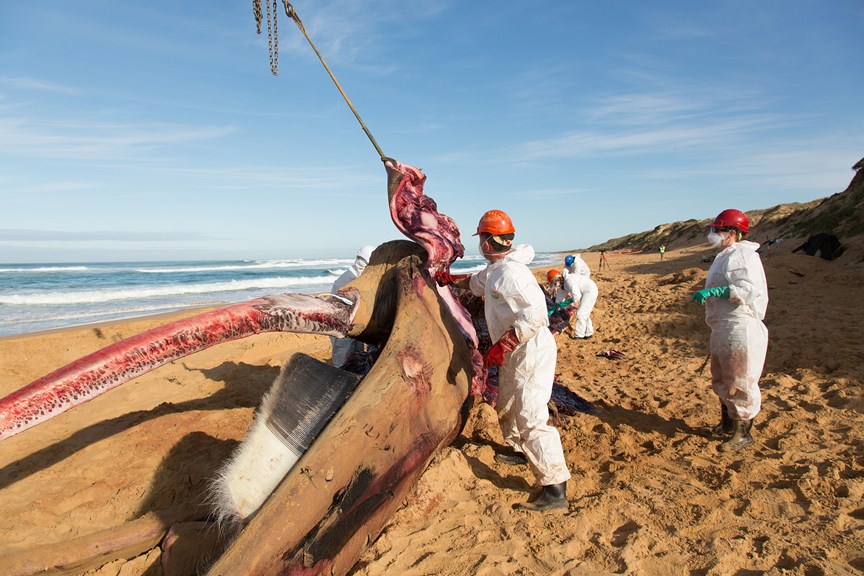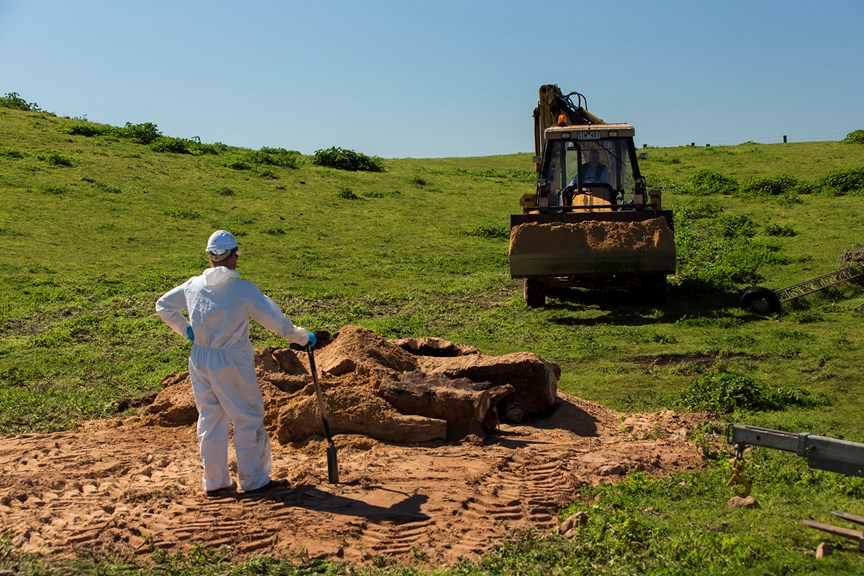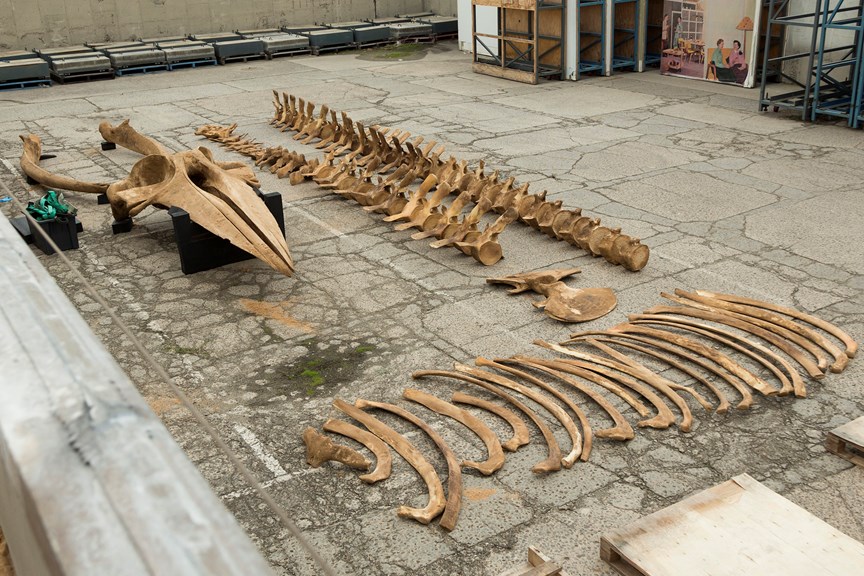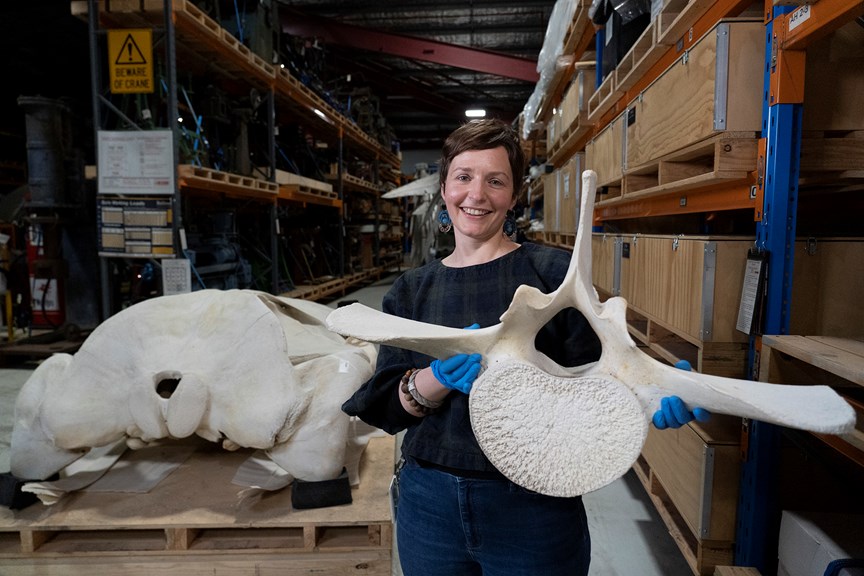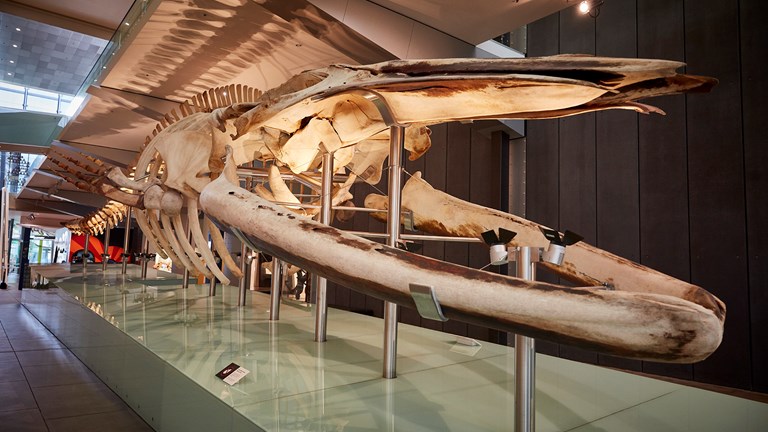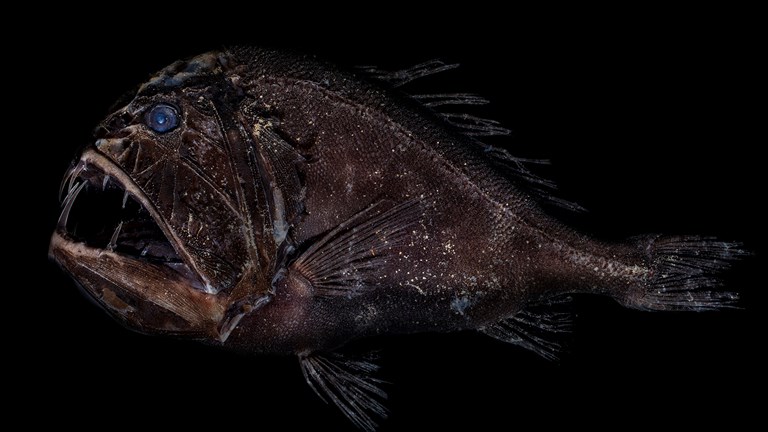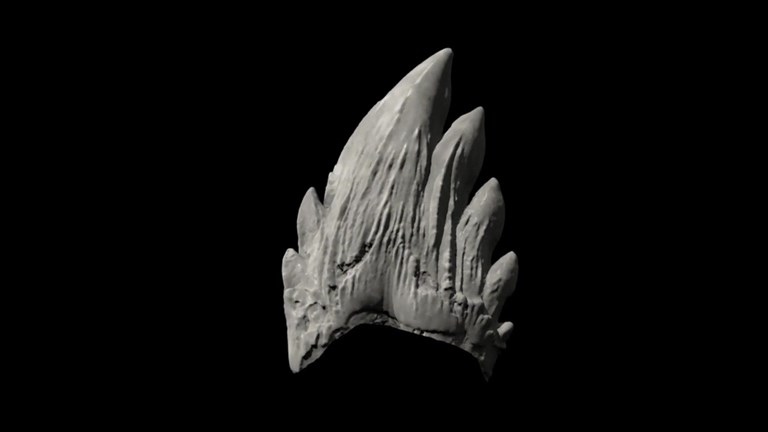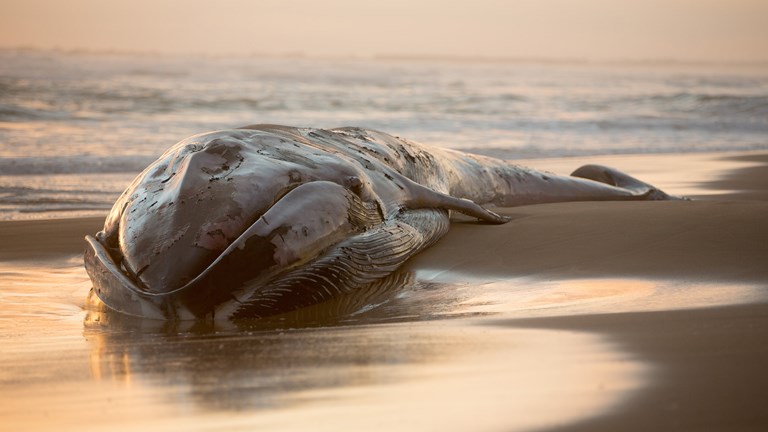
Recovering a rarity: what happens when a dead Fin Whale washes ashore?
The stranding of a dead whale offers scientists a rare opportunity to study these elusive giants up close, but collecting an animal like the Fin Whale is a big challenge.
Content warning: this article contains graphic images of a whale dissection.
When a dead whale washes ashore it attracts a lot of attention from locals and wildlife, but hot on their heels is usually a team of scientists eager to get their hands very dirty.
Animals like this Fin Whale, that washed up on a beach near Warrnambool on Victoria’s west coast in 2014, are a rare opportunity to study an ordinarily elusive animal up close.
Museums Victoria preparators, like Brendon Taylor, though—they go to collect.
‘We’ve got a fairly quick turn-around to get organised and get moving,’ says Brendon.
‘These things may get washed out to sea again, there are a whole range of things that can happen very quickly, so we have to be very fast off the mark. ‘
The work may not be everyone’s idea of fun, but it is worth it for a specimen like this.
‘This is the first Fin Whale that will be in the museum collection so it’s actually quite important and quite a rare whale,’ says Brendon.
‘The big goal would be to get a whole skeleton out; sometimes that’s not possible,’ says Brendon.
‘Greyhounds of the sea’
Fin whales are the second largest animal in the world, behind blue whales.
They are visually quite similar to sei and blue whales but there are some tell-tale signs to look out for.
‘It’s distinguished by the colouration around the head—on the right side of the animal it’s much paler on the head and the left side is darker,’ says Dr Kate Robb, Director of the Marine Mammal Foundation and a research associate at Museums Victoria.
‘It also has different colouration in its baleen plates…and, like the name suggests, has a dorsal fin towards the tailstock.’
Fin whales are nicknamed the ‘greyhounds of the sea’ for their slender, streamlined build and ability to swim very quickly.
They are found all over the world and are a threatened species in Australian waters, mostly due to commercial whaling in the 1900s.
Little is known about them in Victoria because, as Kate explains: ‘They’re very rarely seen.’
‘It’s not that they’re not out there, it’s just that we haven’t done the surveys to be able to have a look at this species.
‘The discovery of this animal on the beach is very exciting for researchers and for the museum because it is a rare opportunity to be able to get so much more information from this animal.'Dr Kate Robb
‘Species distribution, size, and reproductive capacity, that sort of thing.’
Fin whales can grow up to 27 metres long but this one is just 16 metres, indicating this one is a juvenile or sub adult.
It still weighs a hefty 25 tonnes, though.
‘We’ll open the animal up and…have a look at the organs but we’ll also collect important scientific samples—liver, kidney, blubber, and of course skin for genetics.’
It is also a chance to determine why it washed up on the beach in the first place, which isn’t immediately apparent.
‘The skin was in good nick, there was no obvious wounds, the baleen plates are still in place, the tongue is quite pink.
‘Apart from the fact that it’s skinny, there are no obvious signs of why the animal died.’
Dismantling
The first step to recovering the skeleton and scientific samples is to move the whale further up the beach away from the waves using two earthmovers.
‘Things this big, we definitely need the machinery to give us that helping hand,’ says Brendon.
Then, it’s time to suit up—trust us, you don’t want to be doing this in clothes you intend to keep, because the smell sticks.
Flensing is the process of removing the blubber from the animal, to separate it from the muscle.
Blubber isn’t just soft fat, it’s an accumulation of tissue to protect whales from everything the ocean throws at them—predators, cold temperatures and the pressure of deep water included.
The days of large-scale commercial whaling may be long gone, but the old tools of the trade remain.
To cut through the blubber, the prep team uses specialised flensing knives that must be constantly sharpened as they work.
‘We cut the blubber into sections and put the slings through holes we cut into the blubber,’ explains Brendon.
‘The machinery slowly lifts up while we cut away and that way we can get off large chunks in relatively quick time.
‘We continue that until we get down to the bones and then we have to cut around them.’
Everything is done carefully and methodically to protect the skeleton, that will be studied by scientists for decades to come.
‘We don’t want to damage the bones in any way,’ says Brendon.
Once the skeleton has been stripped as much as it can be by human hands, it is time for nature to take over.
Bury it
A nearby private farm is the next stop for most of the Fin Whales skeleton, where it is placed on the ground and covered with sand.
‘We can go back at a later stage and pick them up and bring them back to the museum to finish off.’
The more delicate bones, meanwhile, have to be treated separately.
‘Things like the flippers and tail of the animal, we usually take them straight back to the museum because they’re full of very small bones,’ explains Brendon.
‘Even on very big animals, the flippers have finger bones.
‘We don’t want to get those confused either—we want to keep left with left and right with right, otherwise everything just gets jumbled.’
After eight months, the whole Fin Whale skeleton is ready to be taken back to the museum.
‘In that time lots of bacteria, insects and microbes have been digesting and breaking down that remaining tissue and they’ve done a fantastic job,’ says preparator Peter Swinkels.
‘We didn’t expect it to be this quick.
‘If it’s left for too long the fusion between plates of the skull can start to pull apart and it becomes very weak.’
Even after months in absorbent sand, there is a lot of oil left in the skeleton.
‘There’s still a little bit of cleaning in places, which we’ll do when we get it back to Melbourne.
‘We’re going to use a high-pressure water blaster and some soapy water to give it a scrub and a final clean.
‘Then we’ll leave it out in the weather for about four months to allow a little bit of rain and sun to do a bit more bleaching and final cleaning,’ says Peter.
Before it enters the collection storage, though, there is one final process—pest control.
All these bugs that have hung on for the journey aren’t allowed into the collection store.
The bones are frozen at -30°C to kill off any of these remaining critters before taking their final resting place.
They won’t remain idle though.
A new home
Museums Victoria is home to about 450 specimens of whales and dolphins, which means we need a lot of space to hold them all.
Large specimens like this Fin Whale are kept in a dedicated storage facility in Melbourne.
‘Having this specimen here means it’s available for exhibition to the public and it’s also accessible worldwide to researchers anywhere who wish to come and study it,’ says Dr Karen Roberts, a collection manager of vertebrate zoology at Museums Victoria.
‘Because there are so few in museums worldwide every single individual that is added to a collection is valuable.’
While some specimens in the collection can be as small as single bones or baleen plates, Karen says having the whole skeleton is much more important, ‘because we can tell much more about the entire animal’.
‘We take those opportunities because they enable us to be able to study [whales] in a way that is very difficult to in the wild.
‘By collecting these specimens we’re actually helping to further understand the living individuals and how we can best protect them in the wild.’
Still curious about why museums collect and display so many whale skeletons? Read on.

